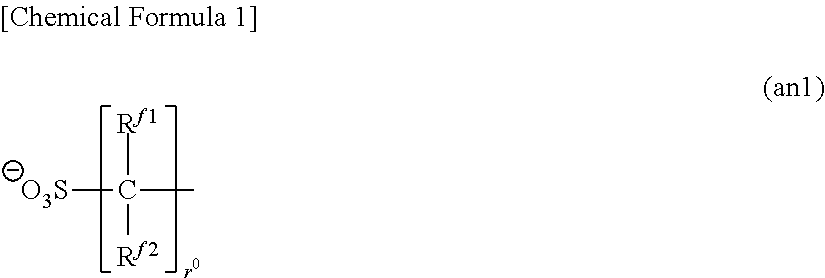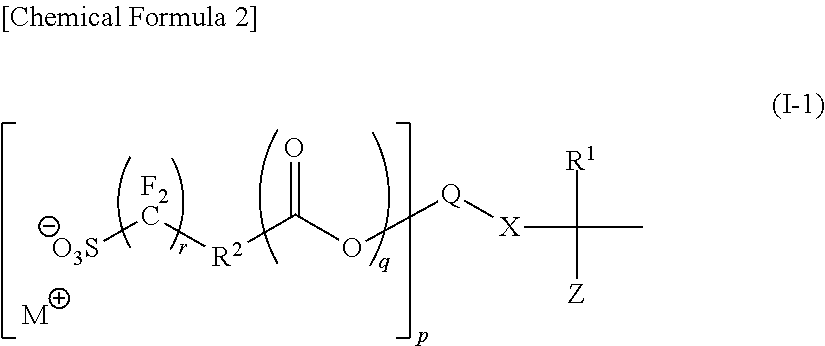Polymer, resist composition and method of forming resist pattern
a technology of resist composition and resist pattern, which is applied in the direction of photosensitive materials, instruments, photomechanical equipment, etc., can solve the problems of color irregularities, inability to meet the required level of lithography properties and pattern shape, and abnormalities in color irregularities, etc., and achieve excellent lithography properties
- Summary
- Abstract
- Description
- Claims
- Application Information
AI Technical Summary
Benefits of technology
Problems solved by technology
Method used
Image
Examples
synthesis example 1
Synthesis of Compound Anion-A
[1259]Under a nitrogen atmosphere, 28.0 g of ACVA and 36.8 g of Anion-a were added to 280 g of dichloromethane, and the mixture was stirred at room temperature. 27.8 g of diisopropylcarbodiimide was added thereto, followed by stirring for 10 minutes. Then, 2.44 g of dimethylaminopyridine was added thereto as a catalyst, and a reaction was effected for 24 hours at 30° C. 1400 g of t-butyl methyl ether was added to the suspended reaction solution, followed by stirring for 30 minutes, and then the precipitated objective compound was separated by filtration, followed by drying, thereby obtaining 20.8 g of Anion-A.
[1260]The obtained compound was analyzed by NMR, and the structure thereof was identified by the following results.
[1261]1H-NMR (400 MHz, DMSO-d6): δ (ppm)=4.61 (dt, 4H, CH2CF2), 2.40-2.65 (m, 8H, CH2CH2), 1.72 (s, 6H, CH3), 1.66 (s, 6H, CH3).
[1262]19F-NMR (376 MHz, DMSO-d6): δ (ppm)=−111.4.
[1263]From the results shown above, it was confirmed that A...
synthesis example 2
Synthesis of compound (I-A)
[1264]10.50 g of TPS—Br, 8.70 g of Anion-A, 155.0 g of dichloromethane and 78.0 g of pure water were added to a beaker, and the mixture was stirred at room temperature for 1 hour. Then, the dichloromethane phase was collected by liquid separation, and repeatedly washed with 78.0 g of pure water. Thereafter, the organic layer was concentrated under reduced pressure, thereby obtaining 13.80 g of a compound (I-A) in the form of a white solid.
[1265]The obtained compound was analyzed by NMR, and the structure thereof was identified by the following results.
[1266]1H-NMR (400 MHz, DMSO-d6): δ (ppm)=7.78-7.90 (m, 30H, ArH), 4.61 (dt, 4H, CH2CF2), 2.40-2.65 (m, 8H, CH2CH2), 1.72 (s, 6H, CH3), 1.66 (s, 6H, CH3).
[1267]19F-NMR (376 MHz, DMSO-d6): δ (ppm)=−111.4.
[1268]From the results shown above, it was confirmed that compound (I-A) had a structure shown below.
synthesis examples 3 to 55
Synthesis of Compounds (I-B) to (I-BB)
[1269]The same procedure as in Synthesis Example 2 was performed, except that the cation moiety of TPS-Br was changed to a cation moiety (equimolar amount) shown in Tables 1 to 18, respecitively. In this manner, compounds (I-B) to (I-BB) shown in Tables 1 to 18 were obtained.
[1270]These compound were analyzed by NMR. The results are shown in Tables 1 to 18.
TABLE 1CompoundNMRCationProductI-B1H-NMR (400 MHz, DMSO-d6): δ(ppm) = 8.50 (d, 4H, ArH), 8.37 (d, 4H, ArH), 7.93 (t, 4H, ArH), 7.55-7.75 (m, 14H, ArH), 4.61 (dt, 4H, CH2CF2), 2.40-2.65 (m, 8H, CH2CH2), 1.72 (s, 6H, CH3), 1.66 (s, 6H, CH3). 19F-NMR (376 MHz, DMSO-d6): δ(ppm) = −111.4.I-C1H-NMR (400 MHz, DMSO-d6): δ(ppm) = 7.72-7.84 (m, 24H, ArH), 7.56 (d, 4H, ArH), 4.61 (dt, 4H, CH2CF2), 3.35 (s, 6H, ArCH3), 2.40- 2.65 (m, 8H, CH2CH2), 1.72 (s, 6H, CH3), 1.66 (s, 6H, CH3). 19F-NMR (376 MHz, DMSO-d6): δ(ppm) = −111.4.I-D1H-NMR (400 MHz, DMSO-d6): δ(ppm) = 7.75-7.86 (m, 20H, ArH), 7.61 (s, 4H, Ar...
PUM
| Property | Measurement | Unit |
|---|---|---|
| Polarity | aaaaa | aaaaa |
| Solubility (mass) | aaaaa | aaaaa |
| Molecular weight | aaaaa | aaaaa |
Abstract
Description
Claims
Application Information
 Login to View More
Login to View More - R&D
- Intellectual Property
- Life Sciences
- Materials
- Tech Scout
- Unparalleled Data Quality
- Higher Quality Content
- 60% Fewer Hallucinations
Browse by: Latest US Patents, China's latest patents, Technical Efficacy Thesaurus, Application Domain, Technology Topic, Popular Technical Reports.
© 2025 PatSnap. All rights reserved.Legal|Privacy policy|Modern Slavery Act Transparency Statement|Sitemap|About US| Contact US: help@patsnap.com



